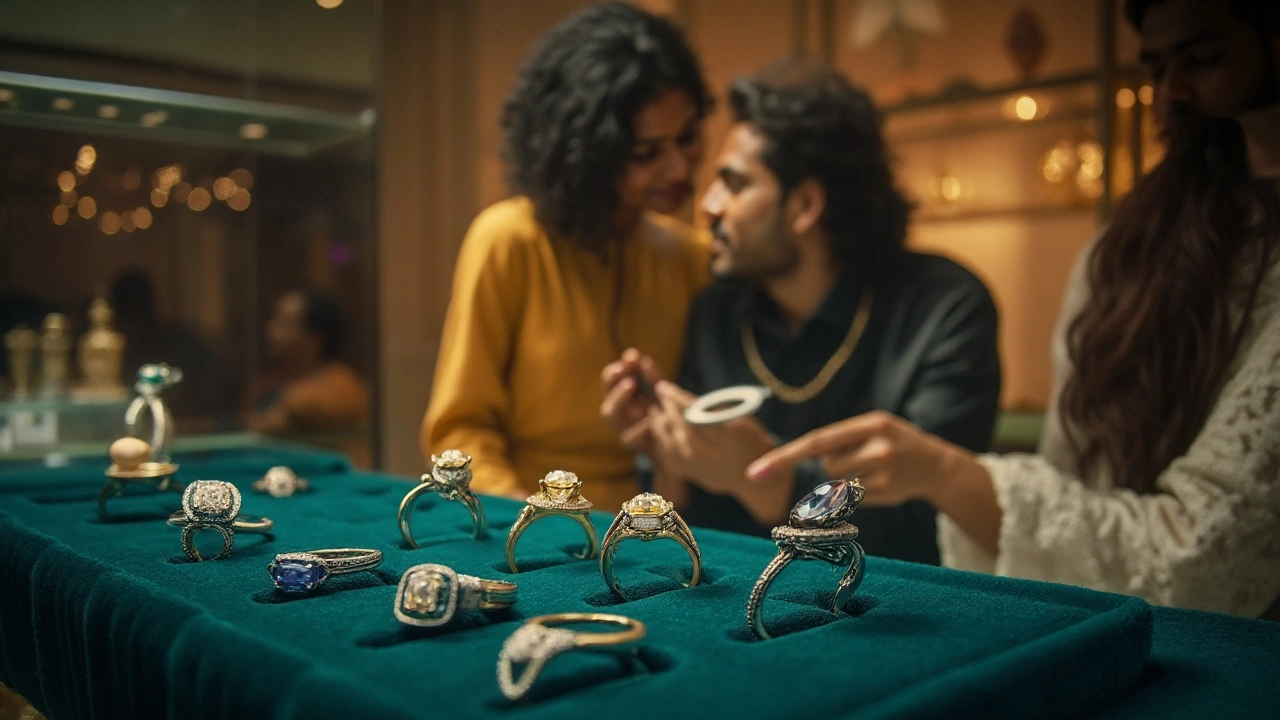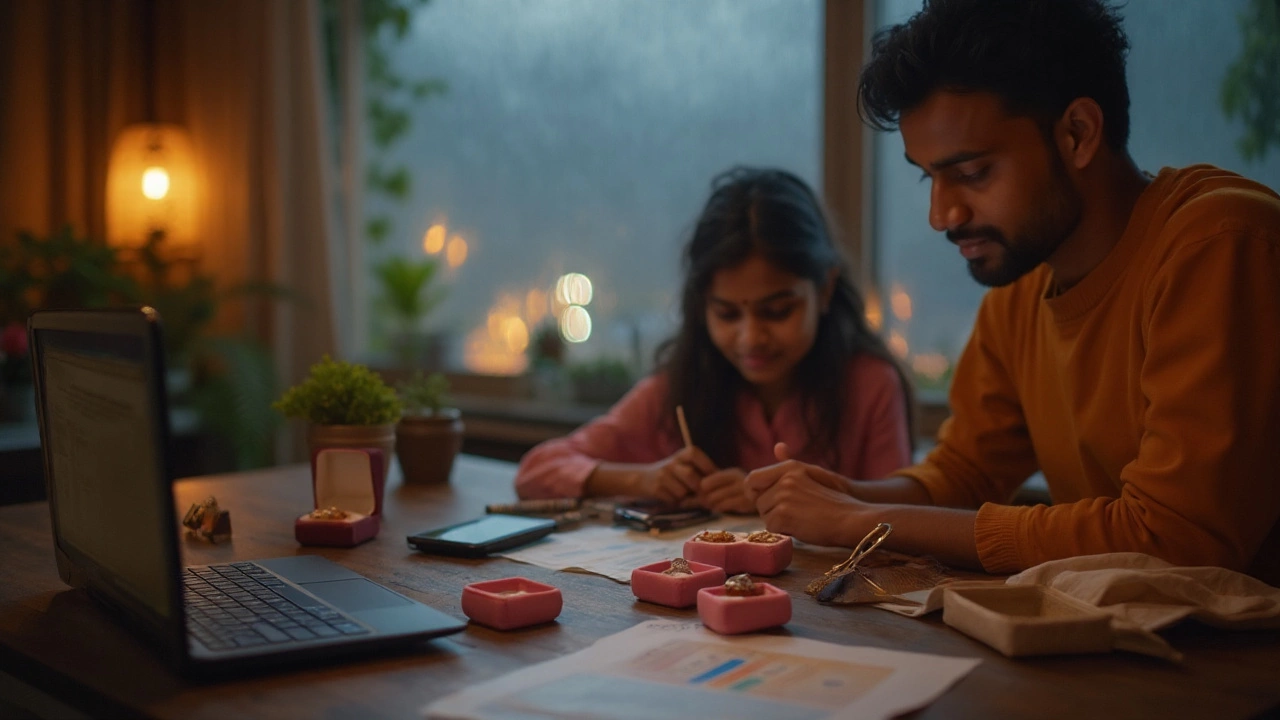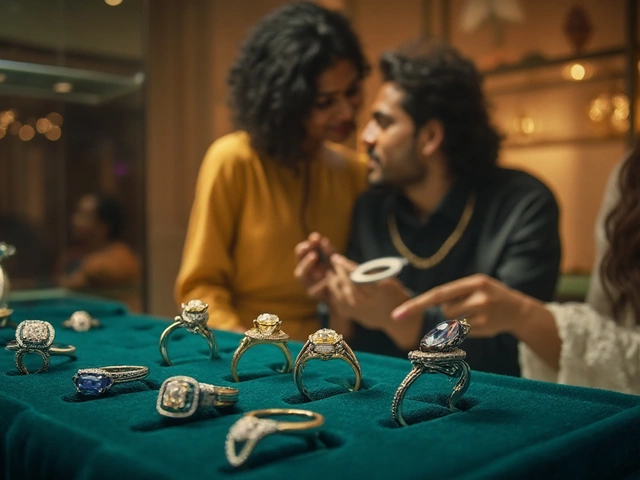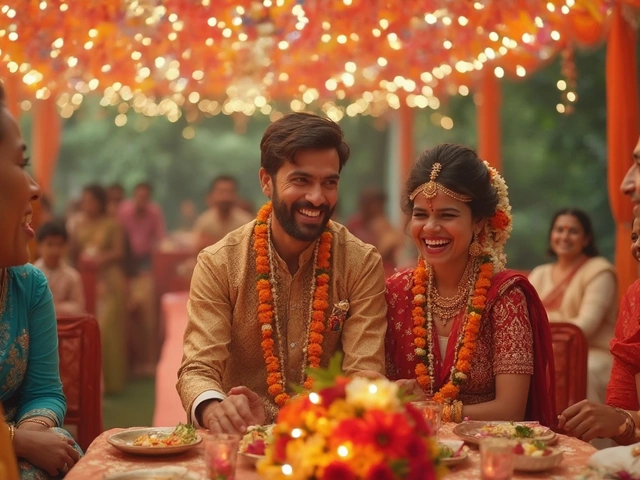
TL;DR
- $10,000 comfortably buys a premium ring: ~1.2-1.6 ct natural diamond or ~2.5-3.5 ct lab-grown, with high-quality cut and a well-made setting.
- Budget split: 75-85% center stone, 10-20% setting, 5-10% tax/insurance/resizing.
- Value sweet spot: Excellent/Ideal cut, G-H color, VS2-SI1 clarity (eye-clean). Prioritize cut.
- Alternatives: Sapphire or moissanite stretch carat size and color for the same spend; expect lower resale.
- Shop smart: Compare local vs online, insist on grading from GIA/IGI, scrutinize fluorescence, return policy, and resizing terms.
Engagement ring is a fine-jewellery piece that symbolizes a marriage proposal, typically featuring a center stone (often a diamond) set in gold or platinum, with attributes like carat, color, clarity, and cut affecting price.
Short answer? Yes-$10,000 is not just enough. It’s a generous budget. In US terms, it’s roughly double the national average spend (The Knot’s 2023 survey hovered near $5,500). In the UK, it’s well above typical budgets (Hitched’s 2023 figure was around £2,100). In today’s market, $10k (~£8,000-£8,200 depending on exchange rates) can buy a brilliant diamond, a sturdy setting, and room for personal details without stress.
What $10,000 actually buys in 2025
Diamond is a crystalline form of carbon used in jewellery, priced primarily by the Four Cs-carat, cut, color, clarity-with rarity and market indices influencing cost.
Market snapshot: natural diamond prices for 1-1.5 ct have softened since 2022, while lab-grown prices have fallen faster due to supply scaling. This puts you in a strong position to prioritize sparkle and size without compromising craftsmanship.
- Natural diamond: Typically 1.2-1.6 ct, Excellent/Ideal cut, G-H color, VS2-SI1 clarity (eye-clean), in a platinum or 18K gold setting.
- Lab-grown diamond: Often 2.5-3.5 ct with similar cut/color/clarity; lab-grown per-carat prices are a fraction of natural.
- Colored stone center: 2-4 ct blue sapphire or ruby in a halo or solitaire; vivid color and origin can swing price.
- Moissanite: 3-4 ct equivalent look for a fraction of the diamond cost; great sparkle, different optical character.
To ground this, think in ratios. With $10k, put most of your money into the best cut you can find, then size, then color, then clarity. A perfectly cut G color, SI1 that’s eye-clean will often look better than a poorly cut F color, VS1.
A quick budget framework that works
engagement ring budget is the lever that determines stone size, cut quality, and setting craftsmanship. Here’s a reliable split that shields you from surprises:
- Center stone: 75-85% ($7,500-$8,500)
- Setting: 10-20% ($1,000-$2,000)
- Everything else: 5-10% ($500-$1,000) for tax, shipping, resizing, appraisal, and first-year insurance
If you’re in a high-sales-tax area (8-10%), scale the stone line down a touch. Buying online from out-of-state may still trigger use tax. In the UK, remember VAT at 20% is often baked into sticker prices; always confirm.
How to squeeze maximum sparkle out of $10k
GIA is the Gemological Institute of America, a standards body known for strict diamond grading of cut, color, clarity, and carat, widely trusted by consumers and the trade.
Ask for certificates from GIA (for naturals) or GIA/IGI (common for lab-grown). Certificates put you and the jeweler on the same page.
- Cut: Choose Excellent/Ideal. It’s the biggest factor in visible beauty. For round diamonds, look for proportions aligned with known “Tolkowsky-esque” ranges; for fancy shapes, ask for videos and ASET/Ideal-Scope images.
- Color: G-H provides a white look in most settings. In yellow gold, you can drop to I-J without obvious warmth.
- Clarity: VS2-SI1 is the value pocket. Prioritize “eye-clean” over the label. Avoid large black inclusions or ones near the table.
- Fluorescence: Faint to Medium can be fine and may even save money; very strong can sometimes make a stone look hazy in daylight-inspect videos.
- Shape: Round costs more per carat than oval, cushion, emerald, or pear. Switching shape can add 0.2-0.4 ct at the same budget.
Four Cs of diamonds is a grading framework-carat, cut, color, clarity-created to standardize diamond quality and pricing comparisons across the trade.
Cut drives fire and brilliance, carat drives size perception, color affects whiteness, and clarity affects transparency. For the naked eye, cut wins.
Natural vs lab-grown vs gemstone: what’s the trade-off?
Natural diamond is a diamond formed in the earth over millions of years, valued for rarity and traditionally stronger resale than lab-grown. Lab-grown diamond is a diamond produced by HPHT or CVD processes with the same chemical composition as natural, typically priced 60-85% lower at retail. Sapphire is a corundum gemstone (Mohs 9) popular for engagement rings, offering vibrant blue and fancy colors, with strong durability. Moissanite is a silicon carbide gemstone (Mohs 9.25) known for high brilliance and fire, often used as a diamond alternative.
Here’s how the options stack up at $10k:
| Center stone | Typical size (at good specs) | Durability (Mohs) | Price range share | Resale expectations | Notes |
|---|---|---|---|---|---|
| Natural diamond | 1.2-1.6 ct | 10 | 70-85% | Moderate (stone holds value better than setting) | Classic choice, strongest tradition; pricing influenced by Rapaport and market cycles |
| Lab-grown diamond | 2.5-3.5 ct | 10 | 55-75% | Low; rapid depreciation common | Big look for the money; demand rising, prices falling over time |
| Sapphire | 2-4 ct | 9 | 40-60% | Varies; fine unheated stones retain value better | Color and origin (Kashmir, Burma, Sri Lanka) drive price more than carat |
| Moissanite | 3-4 ct equiv. | 9.25 | 20-35% | Low | Very bright; different sparkle character than diamond |
Metals, settings, and durability choices
Platinum is a dense, hypoallergenic precious metal favored for prong durability and a naturally white color; it tends to develop a soft patina rather than wear away. Gold (18K) is an alloy of 75% gold with metals for hardness; available as yellow, white, or rose, balancing durability and warmth.
- Platinum vs 18K white gold: Platinum costs ~10-20% more for similar designs, but holds stones securely and doesn’t require rhodium replating.
- Setting style: Solitaire maximizes stone spend; halos add perceived size; pavé adds sparkle but increases maintenance.
- Prong count: 4-prong shows more stone; 6-prong adds security. For ovals/pears, consider V-tips on points.
Comfort is a feature. Ask for a “comfort fit” band interior and smooth basket edges to avoid snagging.
Where to buy and how to compare
Retail channel matters as much as specs.
- Local independent jeweler: Hands-on service, custom options, quick cleaning/checks. Prices vary; negotiation may help.
- Online specialist: Wide inventory filters, videos, better price transparency, strong return policies standard (often 14-30 days).
- Heritage luxury brands: Premium build and branding, ~30-70% brand uplift on equivalent specs. You trade carat for label.
- Vintage/estate: Value on craftsmanship and uniqueness. Have prongs and wear assessed; request a fresh independent appraisal.
Always compare a few stones side by side, even if you plan to buy online. Video in diffused light, spotlight, and daylight window light tells the truth.
Sample $10,000 builds (realistic mixes)
- Natural diamond classic: $8,200 on a 1.40 ct round, Excellent cut, H color, SI1 (eye-clean). $1,300 for a platinum 6-prong solitaire. $500 for tax/resize/insurance setup. Remainder as buffer.
- Lab-grown showstopper: $6,200 on a 3.00 ct oval, Ideal cut, G color, VS1. $1,800 for a delicate pavé platinum cathedral. $700 for insurance, appraisals, and resizing. Balance for matching wedding band fund.
- Blue sapphire statement: $5,500 on a 3.00 ct vivid royal-blue sapphire (heated, Sri Lanka). $2,000 for a platinum halo with tapered baguettes. $800 for tax/insurance. $1,700 left to upsize the sapphire or finish with a hand-engraved shank.
- Moissanite + craftsmanship: $1,200 on a 3.00 ct equivalent colorless moissanite. $2,800 on an artisan hand-forged platinum solitaire with knife-edge shank and bespoke claw prongs. $600 for admin costs. Leaves room to splurge on wedding bands or honeymoon.
How pricing is set (and how to read it)
Rapaport Price List is a widely referenced wholesale benchmark for natural diamond pricing by size, color, and clarity, informing but not dictating retail prices.
Natural diamond retail prices anchor to trade lists, then shift with market demand, cut quality premiums, and retailer margin. Lab-grown pricing follows manufacturing cost curves and retail competition; it’s more volatile. Gemstones are a different world-origin, treatment (e.g., heat), and color saturation are king.
What this means for you: two 1.40 ct “H SI1 Excellent” stones can be 10-20% apart because of cut precision, inclusion type/location, and light performance. Always use the certificate as the starting point, not the finish line.

Hidden costs and how to avoid them
- Resizing: Usually free once; subsequent resizes can be $60-$200. Eternity bands are harder (sometimes impossible) to resize.
- Maintenance: Prong checks every 6-12 months. Pavé may need occasional stone tightening.
- Insurance: 0.8-1.5% of ring value per year with a jewelry specialist insurer. Need a current appraisal.
- Appraisals: $75-$200. Verify the grader’s credentials and independence.
- Taxes and shipping: Clarify at checkout; international purchases may add duties.
Ethics, sustainability, and transparency
Ask about origin and chain-of-custody. Natural diamonds may carry provenance documentation; Canada-grown or traceable African sources are common talking points. Lab-grown avoids mining but uses energy-request energy source details if sustainability matters to you.
Don’t be shy about certifications: GIA for natural diamonds is the gold standard. IGI has strong coverage in lab-grown. De Beers’ 20th-century “two months’ salary” rule was advertising, not a financial plan; surveys today show people spend what fits their priorities and life stage.
Reality check: is $10k too much or too little?
It depends on your income, savings goals, and what your partner values. If a designer label or a 2+ ct natural is non-negotiable, $10k might feel tight. If sparkle and size are the aim without brand tax, it’s plenty.
Quick heuristic: If your emergency fund isn’t fully funded, consider pausing or choosing lab-grown, sapphire, or moissanite. You can always upgrade on an anniversary.
Related concepts you’ll likely explore next
- Wedding bands: metal match, profile comfort, and flush-fit with your engagement setting.
- Metals education: platinum vs 18K vs 14K longevity and maintenance.
- Certification literacy: how to read a grading report line by line.
- Ring sizing and ergonomics: band width, cathedral vs low-set baskets, daily wear comfort.
- Insurance basics: agreed value vs replacement value policies.
Natural language definitions (for clarity)
Here are concise definitions for the big terms you’ll see while shopping:
Lab-grown diamond (CVD/HPHT) is a man-made diamond grown by chemical vapor deposition or high-pressure high-temperature processes, identical in composition to natural.
Halo setting is a ring design with small stones encircling the center, increasing perceived size and sparkle.
Pavé is a setting style where small stones are set closely with tiny beads of metal, creating a paved surface of sparkle.
Practical buying checklist
- Decide on center-stone type first (natural, lab-grown, sapphire, moissanite).
- Lock top three specs that matter to you (cut, shape, size).
- Insist on a grading report (GIA for natural; GIA/IGI for lab-grown).
- Request high-resolution videos and performance images (ASET/Ideal-Scope) for fancy shapes.
- Pick a setting that matches lifestyle: low profile if very active, more prongs if you’re hard on jewelry.
- Confirm return/resizing policy, lead time, and service schedule.
- Get an independent appraisal and set up insurance within 30 days of purchase.
Is $10,000 enough? The simple take
Yes. It’s more than enough to create a beautiful, secure ring with sparkle that stands up to daily wear. With a smart spec mix, you’ll get a stone that looks bright in real life, a setting that lasts, and peace of mind built into the paperwork.
Frequently Asked Questions
What size diamond can I expect for $10,000?
For a natural diamond, budget on 1.2-1.6 ct with Excellent/Ideal cut, G-H color, VS2-SI1 (eye-clean). For a lab-grown diamond, 2.5-3.5 ct is realistic with similar specs. Non-round shapes (oval, pear, cushion) can push size further at the same cost.
Is a lab-grown diamond a good idea at this budget?
If you want a larger look or you value sustainability claims, yes. You’ll likely get ~2-3x the carat for the same price. The trade-off is weak resale value and ongoing price declines. If you care about long-term value retention, a natural diamond or a fine sapphire may fit better.
How should I split the $10,000 budget?
A practical split is 75-85% for the center stone, 10-20% for the setting, and 5-10% for tax, resizing, appraisal, and insurance setup. If you live in a high-tax area, adjust the stone budget downward slightly to avoid last-minute overruns.
Which diamond specs give the best value?
Prioritize cut first. Then aim for G-H color and VS2-SI1 clarity that’s eye-clean. This combo spends money where your eye notices it-sparkle and size-without paying for invisible upgrades. Always verify with videos and a GIA (natural) or GIA/IGI (lab-grown) report.
Is platinum worth it over white gold?
If you want extra prong security and a metal that doesn’t need rhodium replating, platinum is worth the premium. 18K white gold is lighter on the budget and can be brightened with periodic replating. Both are durable for daily wear-choose based on maintenance preferences and feel.
Should I buy from a local jeweler or online?
Both can be great. Local jewelers offer face-to-face service and easy maintenance; online specialists offer broad selection and transparent pricing. Look for clear return policies (14-30 days), high-quality videos, independent grading, and solid aftercare either way.
What about sapphires or moissanite instead of diamond?
Sapphires (Mohs 9) are durable and deliver rich color, with price driven by hue and treatment. Moissanite (Mohs 9.25) offers a large, bright look for far less money, with a different sparkle character than diamond. Both let you upgrade setting craftsmanship while staying under $10k.
How do I protect the purchase after I buy?
Get an appraisal, photograph the ring, and set up jewelry insurance (often 0.8-1.5% of value per year). Schedule prong checks every 6-12 months, especially for pavé or halos. Keep the grading report and receipts in a safe place; your insurer may need them for replacement.



Comments
Post Comment